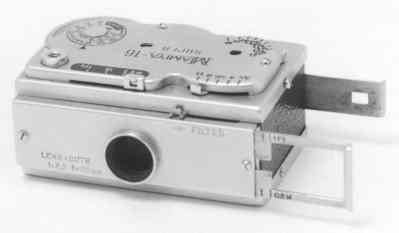
Mamiya 16 Super (II)
In 1957, Mamiya figured out how to improve on perfection and came out with
the Mamiya 16 Super (II). This model is nearly identical to the Mamiya
Super 16 (I) except for a couple of changes. After all, I didn't say they
improved on perfection "a lot". It's not easy to identify a 16 Super
(II) -- it's only marked "Mamiya 16 Super" without a model designation --
but all of the f-stops are marked -- unlike the model I. In addition,
the focusing scale is no longer engraved into the metal of the camera, but
is on a thin, black plastic scale. This allowed for easy manufacture
of both metric (to 0.3 meters) and US (to one foot) scales for different
markets. Another nice touch to look for is the marking of the film-plane
on the top of the camera -- just like the "big boys". Finally, a film
reminder dial now appears on the top of the camera-- for noting the film
speed (in ASA and DIN), film type (B&W or color) and EMPTY.
Otherwise all camera features and operations are the same as
with the Model I. It has a 25mm (f3.5-11) focusing lens -- marked "CUTE"
on the front of the camera. A scale on the top of the camera allows
focusing from infinity to one foot. The pop-out viewfinder has parallax
correction. Shutter speeds of B, 1/2-1/200. A built-in, slide-in
filter-holder -- with a little lever on the front of the camera -- slides
the filter in and out, while a tiny trap-door on the bottom allows the filter
to be changed. Mamiya made several round filters that can be used on
this camera: yellow, green, red, skylight, 85B, and neutral density.
This model has flash synch -- but it's not a standard PC connector.
The flash contact screws into the bottom of the camera -- inside the
tripod socket! So it will only work with special flash gear, but this
connection can also be used as a regular tripod socket. The camera
was often sold in a kit with three rolls of film, camera case, flash attachment
and flash bulbs. Here's a depth-of-field chart.
COPYRIGHT @ 1995, 1996, 1997, 1998, 1999, 2000, 2001, 2002, 2003, 2004, 2005 by Joe McGloin. All Rights Reserved.

